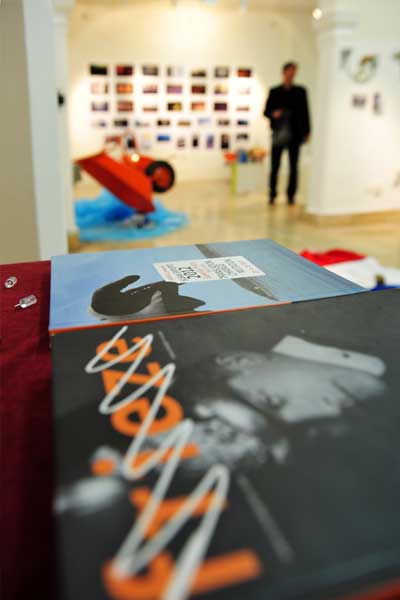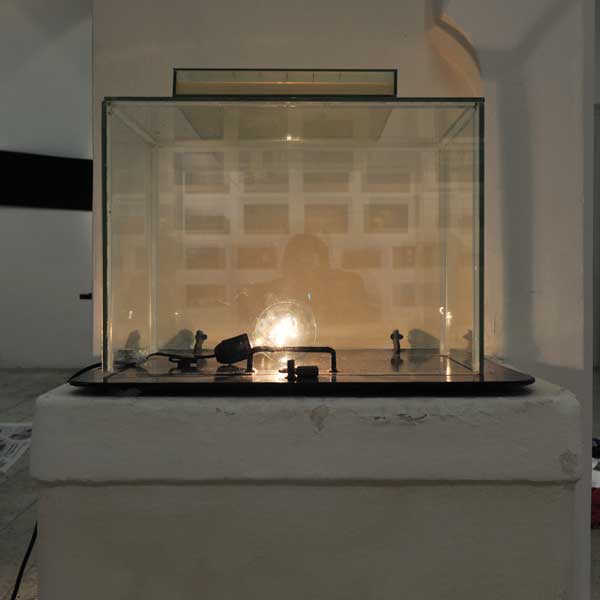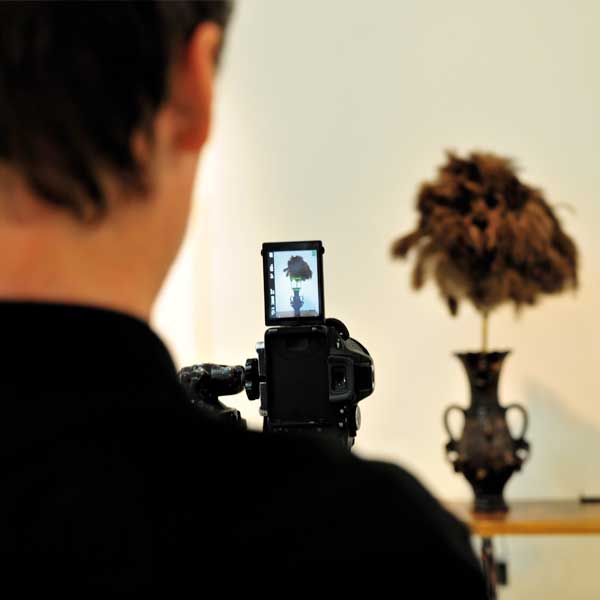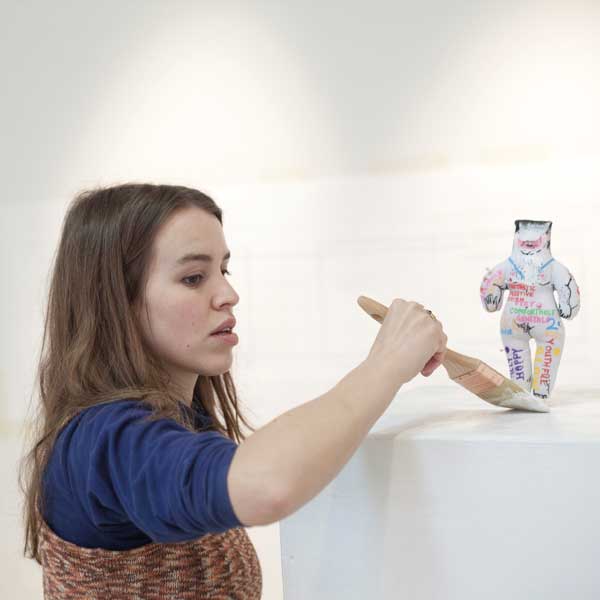SUSAK EXPO[RT] 2012
TRANSLATION | CHANGE | MUTATION
.
curated by KERAN JAMES & HERZOG DELLAFIORE
IRIS DOSTAL | JANKO MATIC | KERAN JAMES | YEN-SIK KIM
ANNA-MARIA BOGNER | ROBIN SEIR | SARAH RECHBERGER
HERZOG DELLAFIORE | KURT-MICHAEL WESTERMAN | PETRA VARL
PETER SEEWASSER | KATE LYDDON | DANIEL DEVLIN | CEDRIC CHRISTIE
HERMANN FINK | JOHN STEPHENS | CHRISTINA BOULA
The Shape of Things to Come
Working within a hegemony dominated predominantly by the promulgation of a paradigm of what was normally seen as singular, unique, original, inspirational, patriarchal art practice we come to understand, the transformation on the viewer, by gazing upon the artefact is indissolubly linked in the originating cause and effect product. Heidegger stated in his essay, The Origin of the Work of Art.: ‘It is the work that first lets the artist emerge as a master of his (sic) art.’ If we take this perspective are we to understand therefore the originator, progenitor, producer framed as co-author is simply the body who constructs, the material realiser if you will, to whom the ultimate conceptual tag of originality and responsibility is attributed. Does it matter? Does it matter? The multiple inflection of this question can simultaneously problematize and ironize the absolutes, the fixities of any construction or indeed any deconstruction which might effect a dislocation. Indeed, a dislocation so profound as to render any text, whether visual or literary redundant in an implosion of post-modernity. In this implosion that is postmodernity, that was post-modernity. ….
Where am I going? Indeed where am I? Where have I been? Let’s start again.
Let’s start from 16 September 1977 on Queen’s Ride, (South West London). Where are you Bolan? Let’s start on 11 January 1994 on 193 Grove Road, London, E17 9BZ. OK read on! Pay attention!
In 1993 Rachel Whiteread cast her iconic house in concrete. Suddenly a familiar internal space was transformed; the personal and private was cast in a white, inert, brutal material and exposed. The innermost, intimate spaces were laid bare, open to the elements. Ironically it had none of the used second hand qualities associated with the familiar brick constructions and being cast from the last in a line of houses that had been demolished, stood like a monolith prompting interpretation and debate regarding memory loss and personal history.
Judging by the negative reaction Whiteread’s work elicited one imagines the public is resistant to change. Yet change is something that requires our constant attention (sic). By looking away and ceasing to attend, the workings of chemistry and biology will affect a gradual, imperceptible transformation; pigment fades, patinas build, varnish cracks, works of art age.
Anarchic preoccupations are adopted by commerce and subsumed into the morass of consumerism rendering them harmless; punk couture mutates into a fashion statement, its political aggression emasculated on the cat walk. Is this what Situationists called the democratisation of art; is this the ultimate reunification of high and popular culture. Does this ‘Recuparation’ effect change? Or does the establishment simply assimilate the radical, tame them and translate into diluted market commodities thus rendering them safe? Yet what pre-occupies is what slips through, what falls between the floorboards of life? What grows, what destroys, what intervenes, what feedback, noise entropy adds or detracts to the experience of creativity and interpretation?
What part of ourselves should we preserve and when we abandon ourselves to the elements and no longer have control, what do we become? Sally Mann’s ethereal photographs of bodies left to decompose naturally on The Body Farm, demystify the processes of decay but simultaneously prompts questions regarding what we are and whether our systems of belief, philosophy, religion are simply a superfluous addendum to the business of biological transformation and decay. Although her work still exhibits the simple strangeness characteristic in these affecting portraits we can no longer seek refuge in form as it implodes metaphorically and literally.
Interstices, borders, gaps, verges, the slightest shift transforms meaning blurring the boundaries of interpretation. If context is 99% of meaning then possibilities for disruption are endless. An artist can (attempt to) dictate what is seen and how it should be viewed, John Baldessari, for example explores the narrative potential of images and the associative power of language within the specific boundaries of the work of art. Yet words and images are purely signals and artists cannot predict the links, net and connections which will be made in the sub conscious of the viewer. Making art is in some ways translating from one context to another changing the meaning.
Barbara Kruger experiments with the idea of gender shift, how masculine and feminine definitions are unstable terms or identities easily exchanged. Throughout her works Kruger makes the viewer re-assess, review and re-evaluate the image, the text, the artist the response and aspects of culture, belief, expectation which we bring to interpretation and the translation of ideas from the art work to our beliefs.
Mathematician Norbert Wiener developed the concept of cybernetics and thus began the exploration of ‘noise elements extraneous to a message which affect its transmission’. What we see here is how disorganisational elements or randomness become the negative of information. During the process of translation, meaning inevitably and inexorably changes; the same words have different connotations in different languages. The translator might understand or interpret things differently bringing cultural belief systems to a text which didn’t exist in the original. The text you are reading may be a translation or may even be the translation of the translation complete with noise elements extraneous to the original message and you probably didn’t notice a thing.
Fleur Axelle
.
.
The Shape of Things to Come
Radeći u hegemoniji kojom uglavnom dominira promulgacija paradigme nečega
što se inače smatra posebnom, jedinstvenom, originalnom, nadahnjujućom praksom u patrijarhalnoj umjetnosti počinjemo shvatati da je preobražaj koji se odvija na gledaocu dok zuri u taj artefakt nerazdvojivo vezan u izvornom proizvodu uzroka i posljedice. Heidegger je rekao u svom eseju Porijeklo umjetničkog djela: „Djelo je ono što prvo dopušta umjetniku da se istakne kao gospodar svoje (sic) umjetnosti.“ Ako zauzmemo takav stav, treba li stoga da shvatimo da je stvaralac, predak, proizvođač ukalupljen u koautora tek tijelo koje izgrađuje, osloboditelj materijala ako baš želite, kojem se daje atribut krajnje konceptualne oznake originalnosti i odgovornosti. Da li je bitno? Da li je bitno? Višestruka fleksija ovog pitanja može istovremeno i problematizovati i očeličiti apsolutne konstrukcije, nepokretnosti bilo koje konstrukcije ili u stvari dekonstrukcije koja bi mogla imati uticaja na dislokaciju. Stvarno, dislokacija tako duboka da bilo koji tekst, bilo vizuelni ili literarni, učini redundantnim u jednoj imploziji post-modernosti. U ovoj imploziji koja je postmodernost, to je post-modernost. …
Đe ja idem? U stvari, đe sam ja? Đe sam bio? Haj’mo ispočetka.
Hajde da počnemo od 16. septembra 1977. u Ulici Queen’s Ride,
(u jugozapadnom Londonu). Đe si, Bolan. Hajde da počnemo 11. januara
1994. na broju 193 u Ulici Grove Road, u Londonu, E17 9BZ. U redu,
čitaj dalje! Pazi ovamo!
Godine 1993. Rachel Whiteread salila je svoju poznatu betonsku kuću. Odjednom se poznati unutrašnji prostor preobrazio; lični i privatni bio je saliven u bijelom, nepokretnom, brutalnom materijalu i ogoljen. Oni najdublji, intimni prostori ostavljeni su goli, otvoreni silama prirode. Ironično, ali nije imala ni jednu od korišćenih, polovnih kvaliteta koje se vezuju za poznate nam građevine od cigle,
a time što je salivena od poslednje u nizu kuća koje su bile uništene, stajala je kao monolit, izazivajući tumačenja i rasprave glede gubitka pamćenja i lične historije.
Sudeći po negativnim reakcijama koje je izmamilo djelo Whitereadove, javnost nije sklona promjenama. Ali, promjena je nešto što zahtijeva našu stalnu pažnju (sic). Odvraćajući pogled i prekidajući pažnju proizvodi hemije i biologije narušiće postepeni, neprimjetni preobražaj; pigment blijedi, patina se nakuplja, lak puca, umjetnička djela stare.
Anarhične zaokupljenosti usvaja trgovina i podvodi ih u glib potrošačkog života čineći ih bezopasnim; pankerski način oblačenja mutira u modni izražaj, a njegova politička agresivnost omlitavi u manekenski hod. Je li to ono što su situacionisti nazivali demokratizacijom umjetnosti; je li to konačno objedinjavanje visoke i popularne kulture. Mijenja li se taj efekat „obnove“? Ili establišment samo izvrši asimilaciju radikalnih, ukroti ih i pretvori u razvodnjenu tržišnu robu čineći ih tako sigurnim? Ali, ono što zaokuplja jeste ono što se propusti, ono što padne kroz procjepe između dasaka koje život znače? Šta uvećava, šta uništava, šta se upliće, koji uzvraćaj, buku entropija dodaje ili oduzima iskustvu stvaralaštva i tumačenja?
Koji dio nas samih bismo trebali da sačuvamo, a kad ostavimo sebe silama prirode i kad više nemamo kontrolu, šta tada postajemo? Eterične fotografije Sally Mann koje prikazuju fotografije tijela ostavljenih da se prirodno raspadnu na farmi tijela demistifikuju proces truljenja ali istovremeno izazivaju pitanja o tome šta smo mi to i da li su naši sistemi vjerovanja, filozofije, religije tek suvišni dodatak poslu biološkog preobražaja i truljenja. Iako njena djela još uvijek prikazuju prosto svojstvo neobičnosti, u tim izražajnim portretima više ne možemo tražiti utočište
u formi, jer ona implodira i metaforično i bukvalno.
Rastojanja, ivice, procjepi, rubovi, najmanje pomjeranje transformiše značenje čineći granice interpretacije nejasnim. Ako kontekst čini 99% značenja onda su mogućnosti za poremećaj beskrajne. Umjetnik može (pokušati) diktirati ono što se vidi i kako da se gleda, John Baldessari, na primjer istražuje narativni potencijal slika i asocijativnu snagu jezika u okviru specifičnih granica umjetničkog djela. Ali, riječi i slike su tek signali i umjetnici ne mogu predvidjeti poveznice, mreže i veze koje će nastati u podsvijesti posmatrača. Stvaranje umjetnosti na neki način jeste prevođenje iz jednog konteksta u drugi, uz promjenu značenja.
Barbara Kruger eksperimentiše sa idejom promjene pola, koliko su muške i ženske definicije nestabilni izrazi ili koliko lako se identiteti zamijene. Kroz sve svoje radove Krugerova tjera posmatrača da ponovno procjenjuje, razmatra i ponovno evaluira sliku, tekst, umjetnika, odgovor i aspekte kulture, vjerovanja, očekivanja koje unosimo u tumačenje i prevođenje ideja od umjetničkog djela do naših vjerovanja.
Matematičar Norbert Wiener razvio je koncept kibernetike i tako je otpočelo istraživanje „elemenata poruci neuobičajenog šuma koji narušava njen prenos“. Ono što ovdje vidimo jeste kako neorganizovani elementi ili nasumičnosti postaju negativ informacije. Prilikom procesa prevođenja, značenje se neizbježno i neumoljivo mijenja; iste riječi imaju drugačije konotacije u različitim jezicima. Prevodilac bi mogao razumjeti ili protumačiti stvari drugačije unoseći kulturološke sisteme vjerovanja u tekst koji nije postojao u izvorniku. Tekst koji čitate možda je prevod, a možda je čak i prevod prevoda, sve sa elementima šuma stranim prvobitnoj poruci, a vi vjerovatno ništa niste ni primijetili.
Fleur Axelle
The Shape of Things to Come
Working in the hegemony that is mostly dominated by promulgation of paradigm
of something which is usually considered as special, unique, original, inspiring practice in a patriarchal art, we begin to understand that transformation which takes place within the viewer while he is staring at this artifact, is inseparably linked to the original product of cause and effect. Heidegger says in his essay, The Origin of Work Art: ‘’The artwork is what first allows the artist to stand out as a master of his (sic) art”. If we take that position, do we, therefore, need to understand that the creator, ancestor, producer stereotyped as co-author, is merely a body that produces, a liberator of the material, if you like to call it that way, which gives the attribute of final conceptual designation of originality and responsibility. Does it matter? Does it matter? Multilateral flexion of this issue can cause a problem but, at the same time, can also harden the absolute constructions, immobility of any construction, or deconstruction, that could have an impact on dislocation. In fact, a dislocation so deep that it can make any text, whether visual or literary, so redundant in an implosion of post-modernity. In this implosion that is postmodern it, actually, is a post-modernity. …
Where am I going? Actually, where am I? Where was I? Let’s start from the beginning. Let’s start from September 16th, 1977, from Queen’s Ride Street (southwest part of London) . What’s up, bro? Let’s start from January 11th, 1994, Grove Road Street, No 193, London, E17 9BZ. Okay, keep on reading! Listen to this!
In the year of 1993, Rachel Whiteread Sally made her famous concrete house. Suddenly, familiar interior transformed, personal and private was cast in white, immobile, brutal and bleak material and bare. The deepest, intimate spaces were left bare, exposed to the forces of nature. Ironically, it did not have any of those used, second-hand qualities that are linked to familiar constructions of brick, and given the fact that it was built out of the last in a series of houses that were destroyed, it was standing as a monolith, challenging interpretations and debates about memory loss and personal history.
Judging from the negative reactions regarding the work of Whiteread’s, public is not prone to changes. But, change is something that requires our constant attention (sic). Diverting the view and interrupting the attention, products of chemistry and biology will harm gradual, imperceptible transformation; pigment fading, patina building up, lakh bursting, art works getting old.
Anarchic preoccupations are adopted by trade and subsumed into the mire of consumers’ life, making them harmless; punk-style way of dressing up mutates into an expression of fashion, and its political aggression softens it to the models-like walk. Is that what Situationists call democratization of art; is it finally merging of high and popular culture. Does that effect of “restoration” change? Or the establishment merely accomplishes assimilation of radical ones, tame them and turn them into weakened market goods, making them safe that way? But, what attracts the attention is what is missed, what falls through the gaps between the boards that stand for life? What increases, what destroys, what interferes, what responds, what noise does entropy add or take away the experience of creativity and interpretation?
Which part of ourselves should we preserve, and when should we leave ourselves to the forces of nature, and when no longer in control, what do we become then? Ethereal photographs by Sally Mann that show bodies left behind to rotten naturally, on the body farm, demystify the process of decay but, at the same time, provoke questions about what we are and are our systems of belief, philosophy, religion only the unnecessary appendix to work of the biological transformation and decay. Although her works still display the unusual simple feature of oddness, we can no longer seek for refuge in the form of those expressive portraits, as it implodes, metaphorically and literally.
Distances, edges, gaps, verges, the slightest move transforms the meaning, making possible interpretations ambiguous. If context makes 99% of the meaning, then possibilities for disorder are countless. The artist can (try to) dictate what to see and how to look at it, John Baldessari, for example, explores the narrative potential of images and associative power of language within the specific boundaries of artwork. But, words and paintings are merely the signals and artists cannot predict links, networks and connections that will occur in the observer’s subconscious. Creating of art is a way to translate from one context to another, with change of meaning.
Barbara Kruger is experimenting with the idea of sex change, how much male and female definitions are unstable expressions and how easy it is to swap identities. Through all her works, Kruger forces the viewer to re-assess, review and re-evaluate the painting, text, artist, response and aspects of culture, beliefs, expectations that bring into interpreting and translating ideas from work of art to our own beliefs.
Norbert Wiener, mathematician, developed the concept of cybernetics and so began the study of “elements of the message of unusual noise which disturbs its transmission.” What we see here is how disorganized elements of randomness become negative of information. During the translation process, the meaning is inevitably and inexorably changed, same words have different connotations in different languages. Interpreter could understand or interpret things differently, by bringing cultural systems of belief into a text that did not exist in its original form. The text you are reading can be a translation, maybe even a translation of the translation, with elements of noise unfamiliar with the original message, and you probably have not even noticed anything.
Fleur Axelle









































![susak expo[rt] 2012 flyer](https://old.susakpress.com/wp-content/uploads/2012/11/susak_export_2012-200x300.jpg)
Leave Comment :